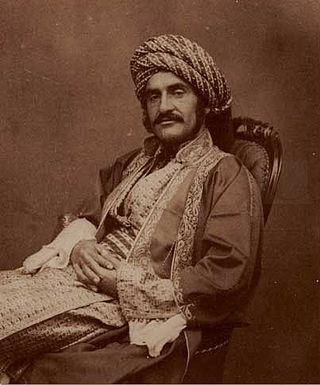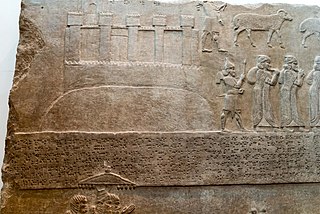Related Research Articles

Nineveh, also known in early modern times as Kouyunjik, was an ancient Assyrian city of Upper Mesopotamia, located in the modern-day city of Mosul in northern Iraq. It is located on the eastern bank of the Tigris River and was the capital and largest city of the Neo-Assyrian Empire, as well as the largest city in the world for several decades. Today, it is a common name for the half of Mosul that lies on the eastern bank of the Tigris, and the country's Nineveh Governorate takes its name from it.

Lieutenant General Augustus Henry Lane Fox Pitt Rivers was an English officer in the British Army, ethnologist, and archaeologist. He was noted for innovations in archaeological methodology, and in the museum display of archaeological and ethnological collections. His international collection of about 22,000 objects was the founding collection of the Pitt Rivers Museum at the University of Oxford while his collection of English archaeology from the area around Stonehenge forms the basis of the collection at The Salisbury Museum in Wiltshire.

Sir Austen Henry Layard was an English Assyriologist, traveller, cuneiformist, art historian, draughtsman, collector, politician and diplomat. He was born to a mostly English family in Paris and largely raised in Italy. He is best known as the excavator of Nimrud and of Nineveh, where he uncovered a large proportion of the Assyrian palace reliefs known, and in 1851 the library of Ashurbanipal. Most of his finds are now in the British Museum. He made a large amount of money from his best-selling accounts of his excavations.

Hormuzd Rassam was an Assyriologist and author. He is known for making a number of important archaeological discoveries from 1877 to 1882, including the clay tablets that contained the Epic of Gilgamesh, the world's oldest notable literature. He is widely believed to be the first-known Middle Eastern and Assyrian archaeologist from the Ottoman empire. He emigrated to the United Kingdom, where he was naturalized as a British citizen, settling in Brighton. He represented the government as a diplomat, helping to free British diplomats from captivity in Ethiopia.

John Robert Mortimer was an English corn-merchant and archaeologist who lived in Driffield, East Riding of Yorkshire.

Nimrud is an ancient Assyrian city located in Iraq, 30 kilometres (20 mi) south of the city of Mosul, and 5 kilometres (3 mi) south of the village of Selamiyah, in the Nineveh Plains in Upper Mesopotamia. It was a major Assyrian city between approximately 1350 BC and 610 BC. The city is located in a strategic position 10 kilometres (6 mi) north of the point that the river Tigris meets its tributary the Great Zab. The city covered an area of 360 hectares. The ruins of the city were found within one kilometre (1,100 yd) of the modern-day Assyrian village of Noomanea in Nineveh Governorate, Iraq.

Dur-Sharrukin, present day Khorsabad, was the Assyrian capital in the time of Sargon II of Assyria. Khorsabad is a village in northern Iraq, 15 km northeast of Mosul. The great city was entirely built in the decade preceding 706 BC. After the unexpected death of Sargon in battle, the capital was shifted 20 km south to Nineveh.
Archaeology is the study of human activity in the past, primarily through the recovery and analysis of the material culture and environmental data that they have left behind, which includes artifacts, architecture, biofacts and cultural landscapes.
Below are notable events in archaeology that occurred in 1888.
Below are notable events in archaeology that occurred in 1893.
Below are notable events in archaeology that occurred in 1883.
Below are notable events in archaeology that occurred in 1881.
The year 1817 in archaeology involved some significant events.

Ashteroth Karnaim, also rendered as Ashtaroth Karnaim, was a city in Bashan east of the Jordan River.
Below are notable events in archaeology that occurred in 1845.
Seton Howard Frederick Lloyd,, was an English archaeologist. He was President of the British School of Archaeology in Iraq, Director of the British Institute of Archaeology at Ankara, Professor of Western Asiatic Archaeology in the Institute of Archaeology, University of London (1962–1969).

Tell Ashtara is an archaeological mound south of Damascus. The Bronze Age city that once stood here may have been mentioned in the Amarna letters correspondence of 1350 BC as Aštartu, and is usually identified with the Biblical city of Ashtaroth.
The decade of the 1790s in archaeology involved some significant events.
Frederick Charles Cooper. was a British artist, traveler and anthropologist of the Victorian era. Cooper accompanied Sir Austen Henry Layard on his expedition to the territory of ancient Assyria in 1849-1850. During this trip, he created a series of detailed watercolors and sketches that captured the ruins and artifacts of Nineveh, the surrounding landscapes of northern Iraq and Syria, as well as anthropological observations and portraits of the artist's contemporaries and expedition participants.
References
- ↑ Thompson, M. W. (1977). General Pitt-Rivers: evolution and archaeology in the nineteenth century . Bradford-on-Avon: Moonraker Press. pp. 105–7. ISBN 0-239-00162-1.
- ↑ Haverfield, F. (1895). "On a milestone of Carausius and other recent Roman finds". Transactions of the Cumberland & Westmorland Antiquarian & Archaeological Society . 13: 437.
- ↑ "Sir Austen Henry Layard - British archaeologist". Encyclopedia Britannica. Retrieved 17 May 2017.